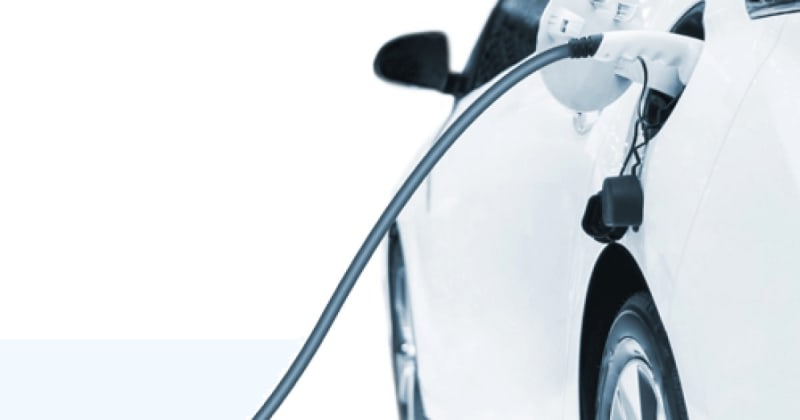and it's available now.
In this Ultimate Guide you will find information about EV's in general as well as charging station locations in Iceland, prices for charging, rental tips and strategies and more.
Feel free to roam around using our "Jump to Chapter" if you know what you are looking for and don't feel like scrolling.
We have a special page just for renting EV's, click here to visit the page and find the perfect EV rental.
- Rental agencies have now embraced a more greener way of achieving greatness, especially when the "rental car apocolypse" and soaring gas prices have overshadowed the rental car conversation.
- EVs are vehicles that use one or more electric motors for propulsion.
- There are three types of EVs; BEV, PHEV and HEV.
- EVs are a fast growing commodity in Iceland where charging stations are now scattered all around the country.
- Tesla Model 3 was the most sold car in Iceland in 2020.
- The cost of charging your car depends on the type of charging you choose:
- Regular charging (25 kWh)
- Fast Charge (DC 50 kWh)
- Fast Charge (DC 150 kWh)
What are Electric Vehicles (EVs) ?
-
An Electric Vehicle (EV) is a vehicle that uses one or more electric motors for driving.
-
It can be powered by a petrol/diesel and battery combination or it can be powered completely by a battery.
-
With increased focus on renewable energy, and the potential impact on climate change and air pollution, the EVs are now soaring in sales and are no longer a rare sight on the road.
Three Types of Electric Vehicles
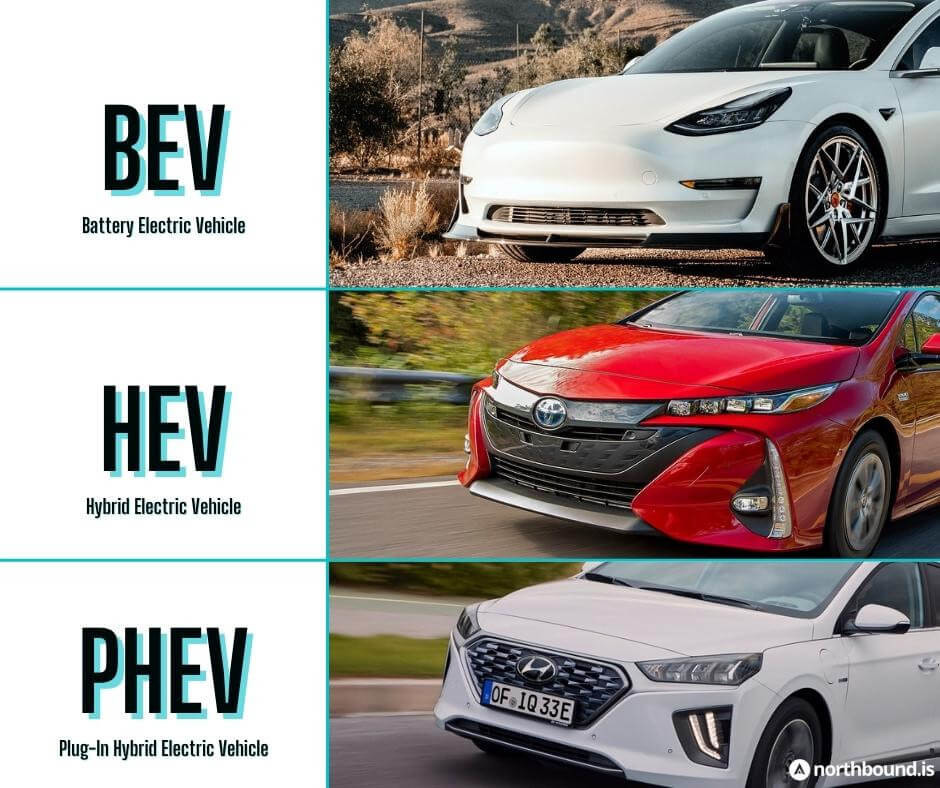
Battery Electric Vehicles (BEV)
- All-Electric vehicles, also known as battery electric vehicles (BEVs), have an electric motor instead of an internal combustion engine (engine that runs on petrol/diesel).
- They have low running costs as they have less moving parts for maintaining and are environmentally friendly.
- EV uses a large battery pack to power it's electric motor and must be plugged in to a wall outlet or a charging station.
- BEVs can be charged at home overnight through your wall socket or you can use charger stations which can fully charge your car in 30 minutes (depending on the charging station), more on that later.
- Since it runs solely on electricity the vehicle emits no exhaust and engine noise is almost non-existent as there is no combustion in the engine. This makes driving an electric car a great experience and environmentally friendly.
- Creates very little noise
- No exhaust, clutch, spark plugs etc.
- Low running cost
- Uses rechargeable batteries instead of fossil fuel.
Hybrid Electric Vehicle (HEV)
- Toyota Prius was the first type of hybrid electric vehicle to hit the market in 1999.
- Without sacrificing performance, the battery in HEV can reduce engine idling when the vehicle is stopped.
- This extra power from the electric motor may also allow for a smaller combustion engine, these features result in a better fuel economy without sacrificing or impacting performance.
There are two types of HEV:
-
Mild Hybrids
-
Use both battery and electric motor to help power the vehicle.
-
They allow the engine to shut off when the car stops (fx. traffic lights) thus further providing a better fuel economy.
-
These types of cars cannot power the vehicle with electricity alone.
-
Full Hybrids
-
Have a more powerful electric motor and larger batteries.
-
They can power the vehicle for short distances and at low speeds.
-
These usually cost more than mild hybrids but the benefit is they provide better fuel economy.
- Better mileage
- No need to stop for charging
- Great for shorter drives
- Less emission than regular cars.
Plug-In Hybrid Electric Vehicles (PHEV)
- PHEV offers a mixture of battery and petrol (or diesel) powered engine and are therefor better for traveling longer distances as the car switches from electricity to fuel when the car is running low on power.
- The disadvantages are the same as having a combustion engine vehicle as they need more maintenance, they are noisy, have emission and add the cost of petrol/diesel.
- PHEV also have reduced range as the battery packs are smaller.
PHEV is different from a Hybrid as you cannot plug in a hybrid car to charge.
- Better mileage
- No need to stop for charging
- Great for shorter drives
- Less emission than regular cars.
Driving an Electric Car
Is driving an electric car different?
- Yes, and No. Driving an electric car is the same as driving one that runs on gas, the difference is in the experience.
- Most indicators, lights, functions and wipers have the same controllers as we are otherwise used to.
- The main difference is there is virtually no engine noise and no exhaust emission. Mostly, the only sound you might notice is the car passing through the wind and the tires on the ground.
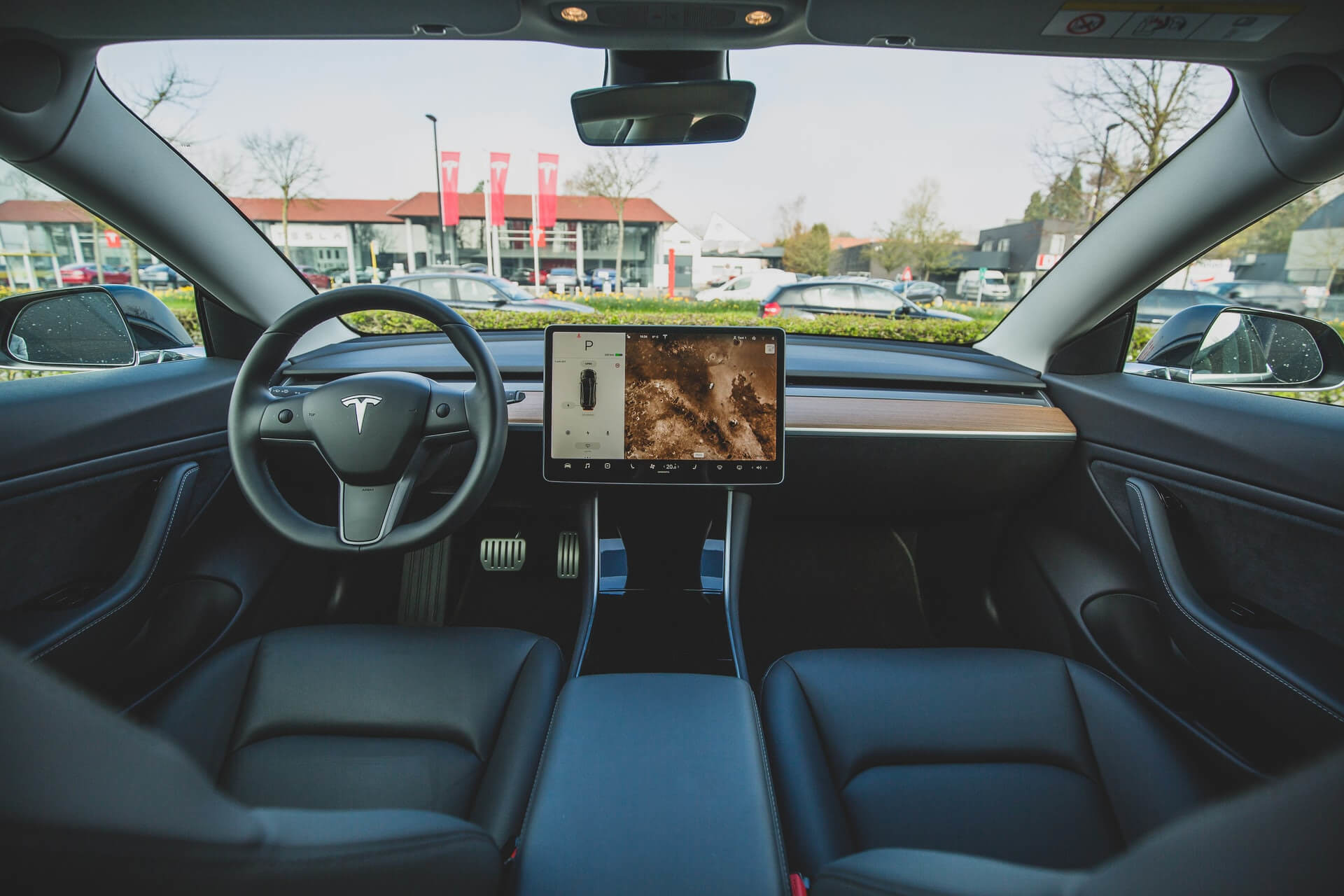
Whats it like driving ?
- Battery powered vehicles (BEV) have no gears and a very rapid acceleration and a lot of torque.
- First time drivers will feel the difference as soon as they step on the peddle as power will be directed to the wheels immediately.
- As you reach higher speeds you will feel it is not as noticeable and driving will feel like something you are used to with other cars.
EVs in Iceland
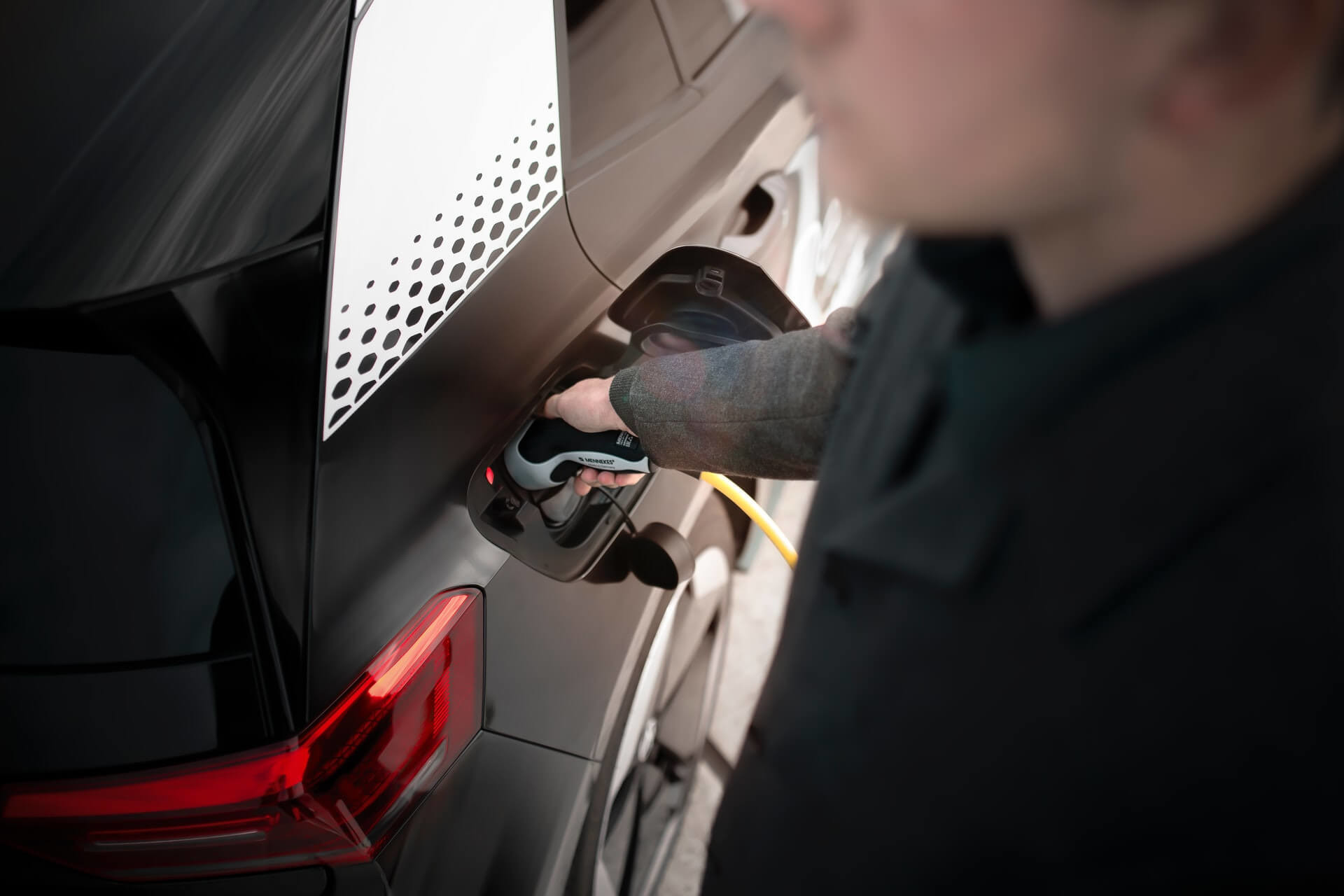
- In recent years Iceland has seen a great spike in EV sales and in 2020 the Tesla Model 3 was the most sold vehicle in the country.
- In April 2022 Mitsubishi Eclipse Cross (PHEV) is leading the charge as the most sold vehicle that month.
- What is so special about Iceland is that it is known for its renewable energy with almost 100% of electricity in Iceland being renewable.
- Petrol is also very expensive due to its geographical location so the EV option for locals is a much needed addition.
- The commute for locals is also relatively short so having a BEV or a PHEV can have a positive impact on both living costs and the environment.
Charging stations in Iceland
According to PlugShare there are plenty of charging stations in Iceland and they are located abundantly around the whole island to make sure you can always plug and charge when in need.
How do you charge your car ?
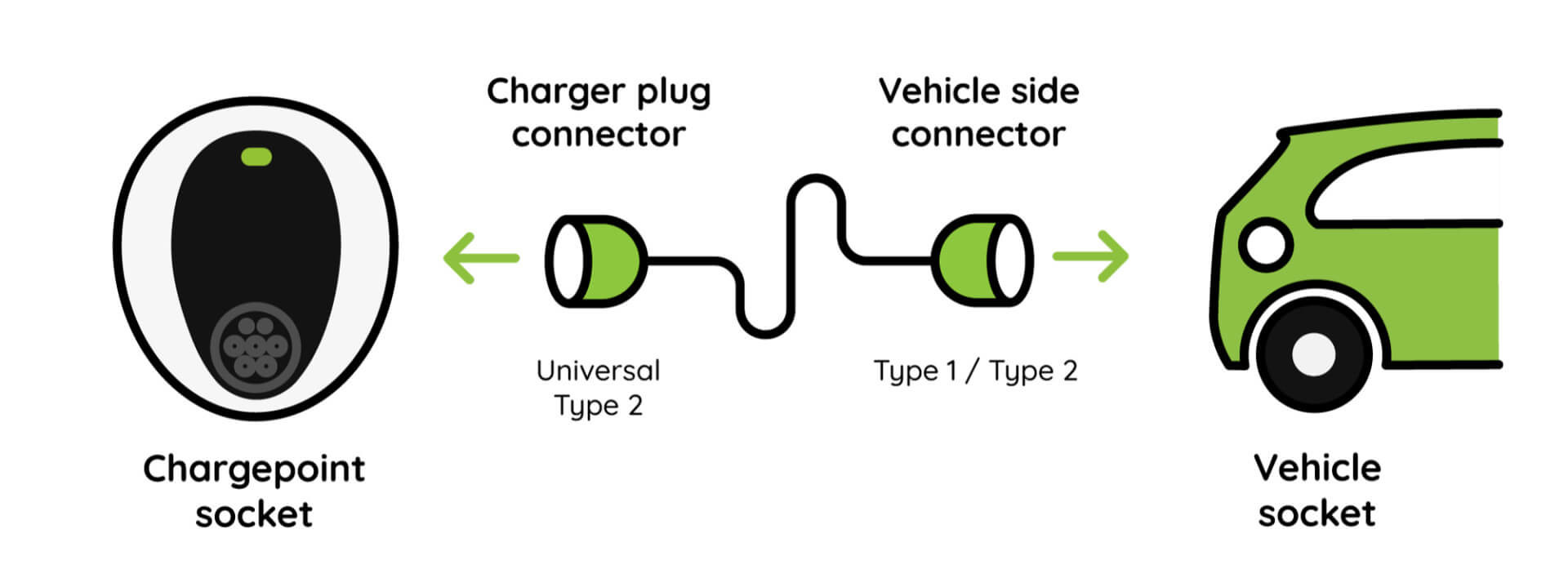
- Similar to charging your phone, there are different types of connectors for different types of EVs. Bellow you will find information about each connector type and what type of car uses each type.
- Type2
- CHAdeMO
- Combined Charging System (CCS)
Slow and Fast Charging
Alternating Current (AC)
- Typically used for top-up charging at home, work and destinations.
| AC Connector Type | Car Types |
|---|---|
|
Type 1 |
Citroen C-Zero
Ford Focus Electric Mitsubishi Outlander PHEV Kia Soul EV Toyota Prius |
|
Type 2 (Most Common) |
KIA
Tesla Ranger Rover Toyota Volkswagen BMW i3 |
Rapid Charging
Direct Current (DC)
- These stations are are typically used for en route rapid charging and take less time to fully charge your car than others.
- All DC (direct current) charging stations will have cables with both a CHAdeMO and CCS connector attached and you will only need to choose which fits the socket on your vehicle.
| DC connector type | Car Types |
|---|---|
| CHAdeMO |
Nissan LEAF Mitsubishi Outlander PHEV |
|
Combined Charging System (CCS) |
BMW i3 Kia e-Niro Jaguar I-Pace Volkswagen e-Golf Tesla Model 3 ( European model ) |
Tesla Superchargers
- It's important to know that only Teslas can use the Tesla high-speed superchargers.
- Iceland has Tesla Superchargers all around the island so you can have care-free driving.
- Supercharger points are the quickest way to recharge, giving you up to 172 miles in just a 15-minute charge.
Regenerative Braking Systems (RBS)
- RBSs transfers kinetic energy of an object in motion into potential or stored energy. This happens when slowing the vehicle down and results in increased fuel efficiency.
- So whenever you brake, slow down or take your foot of the gas peddle, you are storing energy to use while driving.
- RBSs are used in almost every electric vehicles and hybrid electric vehicles.
The Cost of Charging in Iceland
The cost of charging your EV can vary between the type of charging (AC 22 kW, Fast Charge (DC 50 kW) or Fast Charge (DC 150 kW)
ON has a tariff list on the price they offer for charging your EV:
Type of Charging - EUR p kWh - USD p kWh
- Regular (AC 22 kW) - 0.18 EUR - $ .19 cents
- Fast Charge (DC 50 kWh) - 0.36 EUR - $ .38 cents
- Fast Charge (DC 150 kWh) - 0.47 EUR - $ .47 cents
Fuel cost calculator
We have made a calculator, so that you can calculate your fuel cost during your trip in Iceland. You can choose petrol, diesel or electric and then where you are traveling. We will show you instantly how much per average you will be spending and how much you would save using an EV.
You can find this calculator, here
- Icelandic Government has put together a draft about the future funding of charging stations around the country to answer the demand of EV rentals in Iceland.
- Gas prices in Iceland are so high compared to other countries that you will see big savings on driving electric in Iceland, no matter the type of EV.
Renting an Electric Car in Iceland
- Traveling green has never been easier and more affordable.
- Renting a car in Iceland can be pricey and saving costs on fuel can go a long way.
- Rental services and agencies in Iceland are offering a wide variety of BEV, PHEV and HEV types of vehicles for hire.
What EVs are Available for Rent?
- All types of EVs are available for rent (BEV, PHEV and HEV)
- EVs are being added to rental agencies fleet regularly but it is all depending on the car manufacturers.
- Most rental agencies are excited about adding EVs do their fleet and are putting in large orders with manufacturers such as:
Example of types of EVs for hire in Iceland:
| Car Manufacturers | Model Examples |
|---|---|
| Tesla | Model Y (fully electric) |
| Toyota | Corolla Hybrid / Prius / RAV4 Hybrid / Yaris Hybrid |
| KIA | Niro & Ceed & Sorento Plug-in Hybrid |
| Volvo | XC40 (fully electric) |
| Ford | Explorer Hybrid |
| Mitsubishi | Eclipse Cross |
| Peugeot | 3008 Hybrid |
| Hyundai | Kona EV (fully electric) |
| Renault | Kadjar Hybrid / Megane Hybrid |
Rental Tips and Strategies

- Hybrid Vehicles (HEV) are more widely available across most rental agencies.
- Some EVs are also allowed on F-roads in Iceland, which mean that they are 4x4's or SUV's.
- When looking for rental cars, always check if there is an "Electric", "Hybrid" or "Plug-in Hybrid" filter for your search.
- Make sure you chose the right type of vehicle that doesn't hinder your travels around Iceland. If you believe that an EV isn't the right choice for you, then go for the option you are more comfortable with.
- Usually EV's have a more modern look and feel to them. They also often offer quality entertainment systems, wireless charging, assisted driving and 180/360 cameras that can keep an eye on your car for damages such as car door slams.
Related: What are F-Roads in Iceland
Save Battery Life and Boost Your Range
Have a light right foot
You can easily save battery by driving "battery" efficient. Having a light right food, using regenerating breaking by stopping slowly and gradually and not being tempted to use all that power every time you accelerate.
Use ECO Driving
When driving a PHEV and for longer distances we recommend you use the ECO\PHEV option. This means that the car uses fuel when it needs to quickly accelerate but the battery when you are holding steady speeds. This saves battery for when you need to use it to save fuel.
Slow down
Stay under 60mph / 95kmph. The speed limit in Iceland is around 56mph / 90kmph on highways, so you will also save on speedking tickets. The Department of Energy says you can save 14% energy by reducing your speed by 10 mph, as well as
Related: Driving in Iceland: Road Rules
Feel the heat
If the weather is warm try to minimize the use of the EVs air conditioning and heater. Most cars are equipped with seat and/or steering wheel heater which do not drain the battery as much. We recommend heating/cooling the car while it's plugged in to save battery while driving.
Plan an efficient route
Try to avoid areas (if possible) that have heavy traffic. Google Maps have introduced eco-friendly routes to help you preserve battery.
FAQ
What if I run out of battery?
Not impossible, but just as possible as with other cars that run on fuel. You always have to have an eye on energy percentage available and make sure you have enough to reach the next charging station or your destination.
A good habit is making sure you charge your car when you stop for a rest stop. There are over 200+ charging stations located all around the island so you should always be close to a charging station.
What Is The Range Of My EV ?
The range does vary between manufacturers, type of car and models. Let's say that the range says 300km that means you can drive 300km without charging the vehicle again but there are variables that can effect the range such as;
OUTSIDE TEMPERATURE
Cold weather can cut electric car range over 40 percent.
VEHICLE WEIGHT
It takes more power to move a vehicle that is heavy and because of that the battery drains quicker.
WIND
Sorry to tell you this but Iceland is rather windy and that might also affect the range of the car. More headwind, more resistance which then means more power needed to drive the vehicle. Pretty straightforward.
You should consider at least a 25% range loss during a winter season long trip. Just plan your trip well and you should be able to charge along your route, try not to cut it too close as the battery might drain quicker than you think.
How Long Does It Take To Charge an EV ?
- With a 50kW rapid charger you can add up to 160 km / 100 miles in roughly 30-40 minutes.
- The bigger your car's battery and the slower the charging point, the longer it takes to charge from empty to full.
- It can be as little as 30 minutes or even more than 12 hours, this all depends on the size of the battery and the speed of the charging station being used.
- Your EV with a 60kWh battery will be charged in around 8 hours, from empty-to-full, with a 7kW charing point/station. We see many drivers just top-up-charge rather than waiting for their battery to be fully charged, which is perfectly fine.
Do Hotels in Iceland Have Charging Stations?
Reykjavik has plenty of charging stations available and most of them are close to hotels.
We have gone and listed 10 hotels that are near charging stations in Iceland to make your choices easier when booking a hotel.
Does It Cost More To Rent an EV ?
No, they do not cost more to rent than other vehicles.
Factors such as type of vehicle (f.x. Compact Car, Family Car or 4x4 SUV), season and availability can effect prices but type of engine usually does not raise the price.
Am I Provided With a Charging Cable?
Yes, with an EV rental all the tools you need are provided: cables & charging solutions. Most charging stations also have charging cables attached but some cables might not fit your car.
We recommend checking Google Maps or PlugShare to check if you can charge your vehicle at each station.
